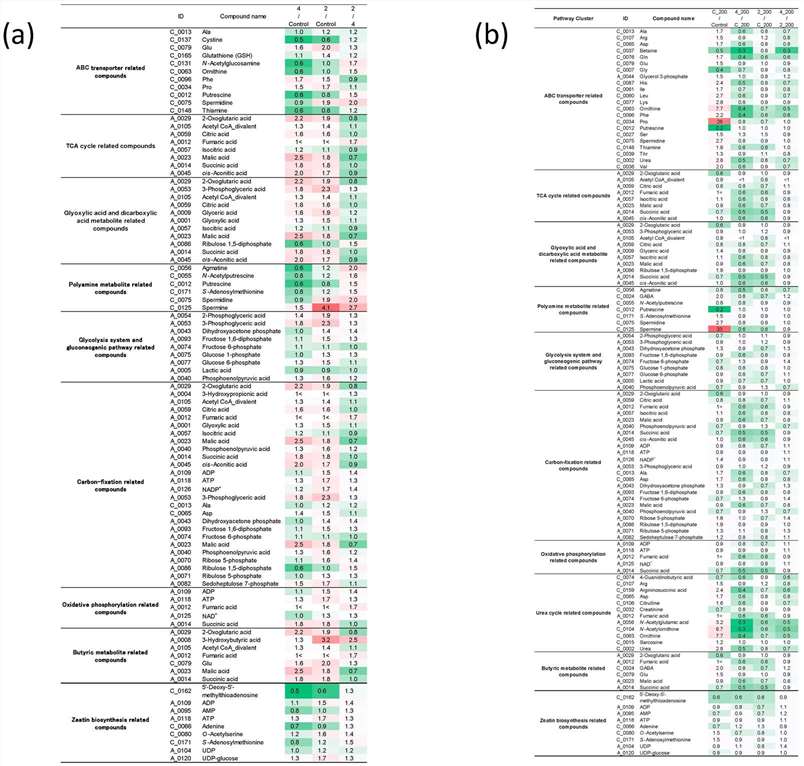Plant growth and development metabolic profiling refers to the systematic analysis and quantification of the various chemical compounds (metabolites) present within plants at different stages of their growth and development. This scientific approach aims to understand how the metabolism of plants changes as they progress from seeds to mature plants, and how these metabolic changes relate to their growth, development, and responses to environmental factors.
Metabolic profiling involves the comprehensive identification and measurement of a wide range of metabolites, including sugars, amino acids, organic acids, lipids, and secondary metabolites, among others. These metabolites serve as the building blocks and energy sources for plants and are involved in various biochemical pathways crucial for growth, development, and adaptation to environmental conditions.
The main objectives of plant growth and development metabolic profiling include:
- Characterizing Metabolic Pathways: Identifying and mapping metabolic pathways involved in key processes such as photosynthesis, respiration, and biosynthesis of essential compounds like proteins, nucleic acids, and phytohormones.
- Understanding Developmental Transitions: Investigating how metabolic changes correspond to different developmental stages, such as germination, vegetative growth, flowering, and fruiting.
- Response to Environmental Factors: Studying how plants adapt their metabolism in response to environmental stressors, such as drought, heat, pathogens, and nutrient availability.
- Crop Improvement: Identifying metabolites associated with traits like crop yield, disease resistance, and nutritional quality to develop strategies for crop improvement and sustainable agriculture.
- Biomarker Discovery: Discovering specific metabolites or metabolic patterns that can serve as biomarkers for monitoring plant health and development.
Plant Growth and Development Metabolomics Solutions
 Nutrient Regulation and Growth Factor Research
Nutrient Regulation and Growth Factor Research
Understanding how plants perceive, absorb, and utilize nutrients and the impact of these elements on plant growth and development.
- Nutrient Optimization: By analyzing changes in metabolites, it is possible to determine the metabolic adaptation strategies of plants under different nutrient conditions, thereby improving crop yield and quality.
- Deficiency Detection: Through metabolomics, nutrient deficiencies in plants can be identified, helping to adjust fertilizers and nutrient supplies, reducing resource wastage.
- Growth Factor Research: Investigating the metabolism and signaling of growth hormones such as auxins, gibberellins, and cytokinins to understand their roles in growth and development.
 Plant Hormone Metabolism and Signaling Analysis
Plant Hormone Metabolism and Signaling Analysis
In-depth study of the synthesis, degradation, and roles of plant hormones in processes such as growth, flowering, disease resistance, and responses to environmental stress.
- Growth Regulation: Identifying key metabolites associated with plant hormones to reveal their roles in cell proliferation, differentiation, and elongation.
- Stress Response: Understanding changes in hormone signaling pathways in response to environmental conditions (e.g., drought, high temperature, salt stress) to develop stress-resistant crop varieties.
- Flowering Regulation: Investigating the role of plant hormones in flowering and how changes in hormone metabolism control the timing of flowering.
 Metabolic Regulation of Pollen Development and Pollination
Metabolic Regulation of Pollen Development and Pollination
Understanding pollen development processes and the interaction between pollen and the female reproductive structures to uncover the molecular mechanisms of plant reproduction.
- Pollen Viability Research: Analyzing metabolites in pollen to identify molecular markers affecting pollen viability and successful fertilization.
- Pollination Process Elucidation: Studying the metabolic regulation of plants during pollination, revealing the growth, guidance, and fertilization mechanisms of pollen tubes.
- Reproductive Strategies: Understanding differences in pollen metabolism among plant species to gain insights into their reproductive strategies and evolution.
Metabolomics Techniques for Plant Growth and Development Studies
Gas Chromatography-Mass Spectrometry (GC-MS):
- Instrument Model: Agilent 7890B GC coupled with Agilent 5977A MS
- Application: GC-MS is widely used for the analysis of volatile and semi-volatile metabolites, including organic acids, amino acids, and fatty acids.
Liquid Chromatography-Mass Spectrometry (LC-MS):
- Instrument Model: Thermo Fisher Q Exactive Plus
- Application: LC-MS offers high sensitivity and is suitable for the analysis of a wide range of polar and non-polar metabolites, including secondary metabolites, sugars, and lipids.
Capillary Electrophoresis-Mass Spectrometry (CE-MS):
- Instrument Model: Agilent 7100 CE coupled with Agilent 6530 Q-TOF MS
- Application: CE-MS is particularly useful for the separation and analysis of charged metabolites, such as amino acids and organic acids.
Data Analysis in Plant Metabolomics
Analyzing the vast amount of data generated by metabolomics experiments is a crucial step. Below, we present a tabular representation of the key components of data analysis:
| Data Processing Steps |
Description |
| Preprocessing |
- Noise reduction |
| - Peak alignment |
| - Missing value imputation |
| Statistical Analysis |
- Univariate analysis (e.g., t-tests) |
| - Multivariate analysis (e.g., PCA, PLS-DA) |
| Metabolite Annotation |
- Compound identification |
| - Pathway enrichment analysis |
| Biological Interpretation |
- Identification of key metabolites |
| - Integration with biological pathways |
Case. Effect of Endophytic Bacteria on the Metabolome and Growth of Ice Plants Under Saline Conditions
Background
This study investigates the influence of endophytic bacteria on ice plants' growth and metabolome under saline conditions. It explores how these microorganisms can potentially enhance plant resilience to salt stress.
Samples
Soil samples collected from different locations in Yamanashi prefecture, Japan, representing diverse environmental conditions and soil types (Cambisols, Andisols, and Fluvents).
Ice plants grown in these soils under varying salt concentrations (50 mM, 200 mM, and 350 mM NaCl).
Technological Methods
Ice Plant Growth and Sodium-Uptake Ability:
- Soil collection, sieving, and pot preparation.
- Ice plant seeds sown and grown for 10 weeks with salt treatments.
- Measurement of plant fresh and dry weights and sodium uptake.
Microbiome of Ice Plants:
- Total DNA extraction from root tissues and surface sterilization.
- Amplification and sequencing of the V4 region of the 16S rRNA gene for microbiome analysis.
- Isolation of endophytic bacteria from plant tissues under high salinity conditions.
Isolation of Endophytic Bacteria:
- Isolation of endophytic bacteria from ice plant tissues after surface sterilization.
- Bacterial culture on specific agar medium with high salinity.
First Screening Step for Plant Growth-Promoting Endophytic Bacteria:
- Evaluation of IAA production by isolated bacteria using Salkowski's reagent.
Second Screening Step for Plant Growth-Promoting Endophytic Bacteria:
- Screening of selected endophytic bacteria for their growth-promoting effects on ice plants.
- Growth of ice plant seeds in bacterial cultures and measurement of growth parameters.
PGPE Characterization and Phylogenetic Analysis of Selected Strains:
- Assessment of phosphate solubilization, siderophore production, and presence of specific genes (nifH and ACCd) in selected strains.
- DNA extraction, PCR amplification, and comparison with databases for taxonomic identification.
Plant Growth under Soil Environmental Conditions:
- Growth of ice plants in soil under specific environmental conditions with or without selected PGPE strains.
- Measurement of plant growth parameters to evaluate the impact of PGPE.
Metabolome Analysis of PGPE Inoculated Ice Plant:
- Harvesting and processing of ice plant samples for metabolome analysis.
- Capillary electrophoresis time-of-flight mass spectrometry (CE-TOFMS) analysis of metabolites.
- Metabolite annotation, quantification, and data visualization on metabolic pathway maps.
Results:
The study revealed significant insights into the effects of endophytic bacteria on ice plants, including their growth-promoting abilities, metabolic changes, and responses to salt stress. The results provide valuable information for understanding plant-microbe interactions in saline environments, potentially contributing to enhanced crop resilience in such conditions.
 Heatmap of major metabolite groups based on comparative ratio in plants inoculated with strain 4 or strain 2 compared with mock-inoculated plants.
Heatmap of major metabolite groups based on comparative ratio in plants inoculated with strain 4 or strain 2 compared with mock-inoculated plants.
Reference
- Kataoka, Ryota, et al. "Metabolomics analyses reveal metabolites affected by plant growth-promoting endophytic bacteria in roots of the halophyte Mesembryanthemum crystallinum." International Journal of Molecular Sciences 22.21 (2021): 11813.


 Heatmap of major metabolite groups based on comparative ratio in plants inoculated with strain 4 or strain 2 compared with mock-inoculated plants.
Heatmap of major metabolite groups based on comparative ratio in plants inoculated with strain 4 or strain 2 compared with mock-inoculated plants.

